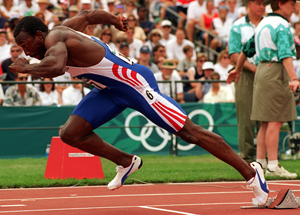Well, what do you say?
Eeeeeeeeek! LOL! Lets just all settle down here…it’s just SIMPLE CURIOUSITY! Surely nothing more!!! 
I would really like to see more pics on this thread. THis is a good rolling conversation piece.
lot of twisting here, recipe for a broken back some day. Left hip dropping. Tough situation of course because this athlete is coming off a hurdle, in an Olympic final, on a bend.
one of the great mysteries as to how she even ran the times she did.
What causes a ‘duck foot’ action to occur (ie. Lauren Hewitt). Is it a result of muscular tightness/imbalance, or is it merely a technical issue?
It was be an individual thing I assume. But I suspect the origin of the problem could be that no attention was paid to developing decent mechanics when she started in the sport.
Practice Makes Permanent - not perfect. Only Perfect Practice Makes Perfect.
From allowing lousy (or in her case, horrendous) technique to develop, you get tight spots and, ultimately, serious injury which also mitigate against efficient mechanics or at least full exploitation of the athlete’s performance potential.
There are athletes who come to the track with muscular imbalances, skeletal problems (one leg shorter, less than ideal curvature of the spine etc) and such issues would significantly adversely affect that person’s ability to execute a sound technical model.
But in most cases, proprioception (awareness of your body - arms, legs etc - in time and space) is a big part of “feeling” whether you are in or out of a good technical position.
And the training program - design and implementation - will also have a huge effect on the athlete’s ability to improve technique whilst developing strength and “fitness”.
It really helps to have a coach with a good technical eye and the knowledge and experience to know the difference between the source of a problem and the symptom(s).
That’s why so many people are interested in what Charlie Francis has to say about training.

Comments?
I was under the impression that the ducking out of ones feet while running was due to one recruiting their glutes out of proportion to their hamstrings. It’s not so much that it’s bad form (it is, but still…) but it’s your body not firing optimally due to a relative weakness or poor movement patterns, which in this case would be in the hamstrings.
This type of running is actually fairly typical of athletes who spend a lot of time in the weightroom. They tend to utilize their glutes/quads a lot more and they have trouble getting their hamstrings to share a brunt of the load.











